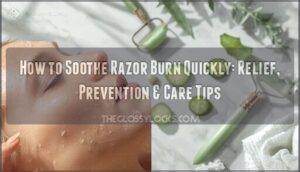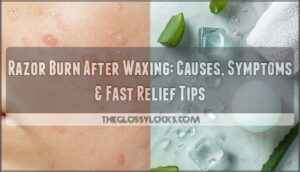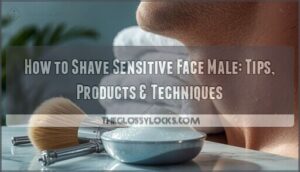This site is supported by our readers. We may earn a commission, at no cost to you, if you purchase through links.
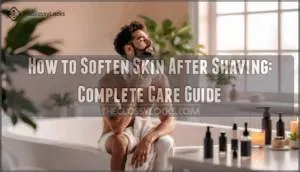 Your skin loses its protective shield each time you shave. The razor removes a thin layer of cells along with the hair, leaving your skin vulnerable to moisture loss and irritation. For the 41% of men who deal with sensitive skin, this microscopic damage triggers immediate reactions—redness, tightness, and that familiar burning sensation.
Your skin loses its protective shield each time you shave. The razor removes a thin layer of cells along with the hair, leaving your skin vulnerable to moisture loss and irritation. For the 41% of men who deal with sensitive skin, this microscopic damage triggers immediate reactions—redness, tightness, and that familiar burning sensation.
The solution isn’t avoiding the razor altogether. Strategic post-shave care can reverse this damage, restoring your skin’s protective barrier and transforming rough, irritated skin into a smooth, comfortable surface. The key lies in understanding what your skin needs in those critical minutes after you finish shaving.
Table Of Contents
Key Takeaways
- Shaving strips away your skin’s protective barrier and microscopic surface layers, causing immediate moisture loss, irritation, and vulnerability—especially for the 41% of men with sensitive skin who experience burning and redness.
- The critical window for preventing dryness is the first few minutes after shaving, when applying moisturizer with ingredients like glycerin (which retains 23% more moisture than alternatives) and cetyl alcohol can restore your skin’s protective barrier and lock in hydration.
- Proper technique matters as much as post-shave care—using a sharp razor, shaving with the grain first, replacing blades every 5-7 shaves, and allowing 48-hour recovery intervals between shaves prevents chronic irritation and ingrown hairs.
- Cold water immediately after shaving closes pores and reduces inflammation, while alcohol-free moisturizers applied within minutes—not hours—make the difference between comfortable skin and prolonged tightness that can last up to 48 hours.
Why Shaving Causes Skin Dryness
You might notice your skin feels tight, rough, or irritated after you shave—and there’s a real reason for that. Shaving disrupts your skin’s protective barrier and strips away essential moisture, leaving you vulnerable to dryness and discomfort.
Let’s look at what’s actually happening beneath the surface and why your skin reacts the way it does.
How Shaving Impacts The Skin Barrier
Every time you shave, your razor doesn’t just remove hair—it strips away a microscopic layer of your skin’s protective barrier, leaving it vulnerable to moisture loss and irritation. This disruption to your skin barrier weakens its barrier function, making moisture retention harder and triggering skin irritation.
Shaving strips away your skin’s protective barrier, leaving it vulnerable to moisture loss and irritation
Your shaving routine basically creates micro-abrasions that compromise your skin’s natural defenses, which is why razor burn and dryness often follow.
Common Post-shave Issues (irritation, Redness, Dryness)
After your skin barrier gets compromised, you’ll likely notice three common problems right away. Here’s what usually happens:
- Skin irritation — About 41% of men with sensitive skin experience reactions after shaving, with burning being especially common.
- Redness causes — Over half of people (57.6%) using cartridge razors show immediate redness, though this usually fades within 24–48 hours.
- Dryness prevention needs — Skin dryness spikes within 30 minutes of shaving and takes about 48 hours to return to normal.
- Shave burn and ingrown hairs — These develop when hair curls back into skin, creating those frustrating bumps.
The good news? Proper post-shave care dramatically reduces these issues. Understanding axillary skin reactions is vital for effective skin care after shaving.
Sensitive Skin and Shaving Challenges
If those issues sound familiar, you’re not alone—people with sensitive skin face an even steeper challenge during shaving without irritation. Sensitive skin reacts quickly, turning minor friction into razor burns and redness.
You’re also more prone to ingrown hairs and razor bumps, especially in sensitive areas. The key is using gentle shaving techniques and proper skin care to minimize skin irritation and support redness relief.
How to Prepare Skin Before Shaving
The key to softer skin after shaving actually starts before you pick up the razor. Proper preparation makes all the difference in preventing dryness, irritation, and that uncomfortable tightness you might feel later.
Here’s what you need to do to set your skin up for success.
Importance of Warm Water and Hydration
Warm water acts like a gentle key that unlocks your pores and softens both your skin and hair, making the entire shaving process smoother and far less harsh on your skin’s protective barrier.
Here’s how warm water therapy aids skin hydration and health:
- Opens pores naturally – Warm water helps moisturize skin by increasing circulation and preparing follicles for gentle cleansing without stripping natural oils.
- Softens hair shafts – These softening techniques reduce tugging and pulling, which protects your skin moisture barrier from damage during shaving.
- Boosts hydration benefits – Well-hydrated skin before you shave or exfoliate creates a protective cushion that minimizes irritation and aids long-term skin health.
Gentle Exfoliation for Smoother Shaving
Exfoliation sweeps away the thin layer of dead cells that can trap hairs and create drag, setting the stage for a blade that glides instead of tugs.
Use gentle peels or a soft scrub once weekly—these exfoliation methods smooth the skin surface, help prevent ingrown hairs, and make your shave prep more effective without over-stripping natural moisture your skin care routine depends on.
Choosing The Right Shaving Cream or Gel
Your shaving cream or gel creates a cushion that protects skin while the razor glides, so look for formulations with glycerin or cetyl alcohol—ingredients that lock in hydration and maintain skin pH balance.
Cream types tend to be richer and offer more moisturizer benefits, while gel benefits include transparency for precision and cooling comfort.
Check that your choice pairs well with your razor care routine and features ingredient safety standards free from drying alcohols or synthetic fragrances that compromise skin protection. For ideal results, consider the shaving gel benefits when selecting a product.
Avoiding Harsh Soaps and Drying Agents
Regular bar soap strips away the natural oils your skin depends on for protection, leaving behind a tight, parched feeling that makes post-shave dryness even worse.
Switch to gentle cleansers or soap alternatives that respect your skin pH balance and support skin hydration. These moisturizer types work with your skin care routine instead of against it, reducing skin irritation and prevention issues while keeping skin protection intact for truly moisturising skin.
Best Shaving Techniques for Softer Skin
The way you shave makes all the difference between smooth, soft skin and irritation that lingers for days. Your technique affects everything from how close the shave is to how quickly your skin recovers afterward.
Let’s walk through the core practices that’ll help you get better results with less trouble.
Using a Sharp, Clean Razor
A dull blade doesn’t just tug at your hair—it actually tears at your skin’s surface, triggering inflammation and leaving micro-damage that can take days to heal. Here’s how proper razor maintenance protects your skin:
- Replace blades every 5-7 shaves to maintain blade sharpness and prevent irritation from dull edges
- Rinse your razor under hot water between strokes to clear trapped hair and maintain a clean razor
- Store in a dry area after sanitizing to prevent bacteria buildup and rust
Shaving With and Against The Grain
The direction you move your razor determines whether you’re working with your hair’s natural pattern or challenging it—and that choice dramatically affects how your skin responds. Start by shaving with the grain—the direction your hair naturally grows—to minimize friction and reduce irritation.
This first pass respects your hair texture and prevents razor burn. For a closer finish, you can carefully shave against the grain on your second pass, but only after you’ve mapped your unique shave patterns and confirmed your skin tolerates these shave angles without excessive redness.
Gentle Pressure and Proper Razor Maintenance
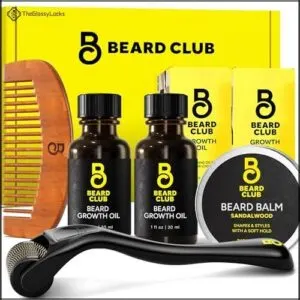 View On Amazon
View On Amazon - Replace dull blades after 5–7 shaves to maintain razor sharpness
- Rinse frequently during shaving for effective blade cleaning
- Store razors in dry locations away from moisture—proper storage tips prevent rust
- Choose grip materials like stainless steel for durability
Shaving Frequency and Skin Recovery
Your skin needs time between shaves to rebuild what the razor strips away—rushing back too soon only multiplies the damage. Most people benefit from 48-hour shave intervals, allowing proper skin recovery and hair growth.
If you notice persistent redness or irritation, extend your recovery time and exfoliate weekly to support skin regeneration. Adjusting shaving frequency based on your skin’s resilience creates a sustainable skin care routine.
Essential Post-Shave Skin Care Steps
Your skin needs attention right after you shave—not hours later. The next few minutes are your best window to lock in moisture and prevent irritation. Here’s what to do as soon as you put down the razor.
Rinsing With Cold Water to Soothe Skin
After you’ve finished shaving, splashing cold water across your skin isn’t just invigorating—it’s one of the simplest ways to calm irritation and tighten pores that have opened during the shave. This quick step delivers real skin-soothing benefits while minimizing redness.
Why cold water works after shaving:
- Closes pores instantly – protecting freshly shaved skin from dirt and bacteria
- Reduces inflammation – cooling sensation calms razor burn before it worsens
- Minimizes redness – constricts blood vessels for a more even complexion
- Gets skin ready for moisturizer – creates the perfect canvas for your post-shave care routine
Moisturizing Immediately After Shaving
Once your skin is cool and refreshed, locking in moisture within the first few minutes makes all the difference in preventing that tight, uncomfortable feeling many people experience after shaving. Your skin barrier needs immediate relief through post-shave care—that’s when moisturizing skin matters most.
| Moisturizer Types | Key Benefits |
|---|---|
| Post shave creams | Deep hydration, restores skin barrier |
| Soothing gels | Lightweight, calms redness instantly |
| Glycerin-based formulas | Retains 23% more moisture than alternatives |
| Alcohol-free lotions | Prevents irritation, aids after shave care |
Choose formulations designed for shaving and skincare to optimize skin hydration and comfort.
Sunscreen Application for Skin Protection
Freshly shaved skin is more vulnerable to UV damage than you might realize, which is why applying sunscreen shouldn’t be an afterthought in your routine. Shaving removes the outermost protective layer, increasing sun sensitivity for 24-48 hours afterward.
- Choose broad spectrum SPF 30+ with physical UV filters like zinc oxide
- Apply moisturizing sunscreens that won’t strip already-compromised skin
- Reapply every two hours when outdoors as part of sun protection measures
- Daily use reduces skin cancer risk while supporting your barrier’s recovery
Avoiding Irritation and Infection Post-shave
The moments right after shaving represent a critical window where even small missteps can trigger inflammation, bacterial invasion, or prolonged discomfort. Keep your hands off freshly shaved areas to prevent infection control issues—touching transfers bacteria that penetrate compromised skin barriers.
Use alcohol-free irritation remedies to maintain skin pH balance, and sanitize your razor between uses for proper bump prevention.
If razor burn develops despite careful postshave care, apply fragrance-free moisturizers formulated for shaving and sensitive skin rather than harsh astringents.
Top Ingredients for Softer, Healthier Skin
When you moisturize after shaving, the ingredients in your product make all the difference. Some work to lock in hydration, while others repair your skin’s protective barrier or prevent irritation.
Let’s look at what to search for on the label and why these components matter for keeping your skin soft and healthy.
Benefits of Glycerin and Cetyl Alcohol
Two ingredients stand out in post-shave skincare for their proven ability to transform dry, irritated skin into something noticeably softer and more comfortable. Glycerin benefits your skin by pulling moisture deep into tissues, with studies showing 23% better moisture retention compared to basic alternatives. Cetyl alcohol works as an emollient, binding hydration directly to your skin’s surface—61% of users report improved softness in their skincare routine.
- Glycerin draws water into your skin, supporting long-term skin hydration and moisture retention
- Cetyl Alcohol creates a protective layer with emollient properties that locks in comfort
- Together, they form the foundation of effective post-shave care for skin health and wellness
How Glyceryl Stearate and Paraffinum Liquidum Help
Beyond glycerin and cetyl alcohol, two lesser-known ingredients—glyceryl stearate and paraffinum liquidum—quietly work behind the scenes to keep freshly shaved skin soft, protected, and free from that tight, uncomfortable feeling.
Glyceryl stearate boosts skin smoothing and post-shave hydration, maintaining softness 31% better than water alone in your skincare routine. Paraffinum liquidum forms a protective shield for moisture retention and skin barrier repair, reducing dehydration by 42%.
These emollient benefits make them essential shaving and skincare allies for lasting skin health.
Market Trends in Post-shave Moisturizers
You’ll notice more brands stepping away from alcohol-heavy splashes toward balms and gels packed with natural ingredients like glycerin, shea butter, and aloe vera—nearly 97% of new moisturizer formulations in 2024 included these.
Consumer preferences are clear: people want alcohol-free, fragrance-free options that support long-term skin health, not just quick fixes.
The post-shave care market is projected to hit USD 6.4 billion by 2035, driven by product innovations like 2-in-1 creams and CBD-infused balms.
Your moisturizing skin routine benefits from this shift toward gentler, science-backed skincare routines.
Tips for Shaving Sensitive or Problem-Prone Skin
If your skin often reacts strongly to shaving, you’re not alone—sensitive and problem-prone skin needs a thoughtful approach to avoid irritation, bumps, and discomfort.
The good news is that a few targeted adjustments can make a real difference. Here’s what you need to know to shave more comfortably and keep your skin calm.
Identifying Your Skin Type and Needs
Understanding your skin’s unique personality—whether it’s oily, dry, combination, or sensitive—is the first step toward preventing post-shave problems and achieving consistently smooth results. Proper skin analysis helps you choose the right products and techniques for tailored care that actually works.
- Oily skin: Use lightweight, non-comedogenic moisturizers to avoid clogging pores
- Dry skin: Apply richer formulas with glycerin and cetyl alcohol immediately post-shave
- Sensitive skin: Skip fragrances and alcohol; exfoliate only once weekly to minimize irritation
Preventing Ingrown Hairs and Razor Bumps
Ingrown hairs and razor bumps occur when cut hair re-enters the skin, triggering inflammation—especially common in those with curly hair or genetic predisposition.
Prevent these issues by exfoliating before shaving to clear dead skin cells that trap hair. Always use sharp, single-blade razors and shave with the grain to reduce follicle trauma.
Apply glycolic acid lotion post-shave, which clinical trials show reduces lesions by over 60%, and moisturize immediately to restore your skin barrier.
When to Give Your Skin a Break
If your skin looks angry—persistent redness, burning, or bumps that won’t quit—it’s telling you to skip the next shave. Give your skin recovery time, usually 48-72 hours between shave intervals, to rebuild its protective barrier.
During these rest periods, focus on gentle cleansing and moisturizing—no harsh products. Your skin sensitivity will decrease when you honor these natural healing cycles, preventing chronic irritation.
Frequently Asked Questions (FAQs)
Can I shave daily without damaging my skin?
Can daily shaving work for your skin type? Yes, with proper technique—use a sharp razor, shave with the grain first, moisturize immediately after, and maintain your razor.
Daily moisturizing and gentle shaving techniques for men and women prevent razor burn and skin damage.
What foods help improve skin softness naturally?
Foods rich in omega-3s, vitamin C, and antioxidants support skin softness from within. Salmon, walnuts, citrus fruits, berries, leafy greens, and whole grains nourish your skin barrier, helping maintain moisture and resilience for Personal Grooming and Skincare routines.
Should men and women use different moisturizers?
Generally, you don’t need gender-specific moisturizers. Skin type variations and hormonal influences matter more than gender.
Choose moisturizer ingredients based on your dermatological differences—whether your skin is oily, dry, or sensitive—rather than marketing labels for personal grooming products.
How long does skin take to heal completely?
Most minor shaving-related skin irritation and post-shave recovery improves within 24 to 48 hours.
Deeper tissue repair from cuts or severe razor burn may require three to seven days for complete wound closure and skin regeneration.
Conclusion
Here’s the irony: most men spend more time researching their razor than the products they use afterward. Yet your blade only touches your skin for seconds, while your post-shave routine determines whether you’ll feel comfortable all day.
The ingredients matter, the timing matters, and your technique matters. When you soften skin after shaving with the right approach—cold water, immediate moisture, protective ingredients—you’re not just preventing irritation.
You’re building resilience into your skin’s barrier, one shave at a time.
- https://pureshave.co.uk/moisturising-matters-hydration-tips-for-post-shave-skin/
- https://www.sciencedirect.com/science/article/abs/pii/S1743609522014564
- https://www.yoprettyboy.com/blogs/our-thoughts/should-you-moisturize-after-shaving
- https://ibizaloe.com/en/after-shave-aloe-vera/
- https://www.nakedarmor.com/blogs/news/top-10-essential-oils-for-shaving








